Solar eclipse of July 2, 2019
| Solar eclipse of July 2, 2019 | |
|---|---|
 Map | |
| Type of eclipse | |
| Nature | Total |
| Gamma | -0.6466 |
| Magnitude | 1.0459 |
| Maximum eclipse | |
| Duration | 273 sec (4 m 33 s) |
| Coordinates | 17°24′S 109°00′W / 17.4°S 109°W |
| Max. width of band | 201 km (125 mi) |
| Times (UTC) | |
| Greatest eclipse | 19:24:08 |
| References | |
| Saros | 127 (58 of 82) |
| Catalog # (SE5000) | 9551 |
A total solar eclipse will occur on July 2, 2019 with a magnitude of 1.0459. A solar eclipse occurs when the Moon passes between Earth and the Sun, thereby totally or partly obscuring the image of the Sun for a viewer on Earth. A total solar eclipse occurs when the Moon's apparent diameter is larger than the Sun's, blocking all direct sunlight, turning day into darkness. Totality occurs in a narrow path across Earth's surface, with the partial solar eclipse visible over a surrounding region thousands of kilometres wide. Totality will be visible from the southern Pacific Ocean east of New Zealand to the Coquimbo Region in Chile and Argentina at sunset, with the maximum of 4 minutes 32 seconds visible from the Pacific Ocean.
Images

Related eclipses
Solar eclipses of 2018–2021
Each member in a semester series of solar eclipses repeats approximately every 177 days and 4 hours (a semester) at alternating nodes of the Moon's orbit.
Note: Partial solar eclipses on February 15, 2018, and August 11, 2018, occur during the previous semester series.
| Solar eclipse series sets from 2018–2021 | |||||
|---|---|---|---|---|---|
| Ascending node | Descending node | ||||
| 117 | July 13, 2018 Partial |
122 | January 6, 2019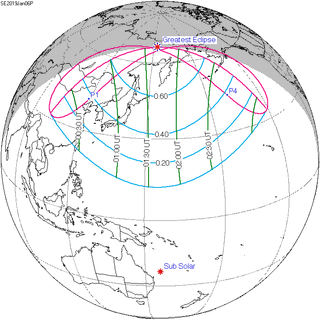 Partial | ||
| 127 | July 2, 2019 Total |
132 | December 26, 2019 Annular | ||
| 137 | June 21, 2020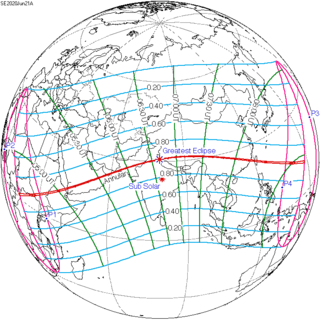 Annular |
142 | December 14, 2020 Total | ||
| 147 | June 10, 2021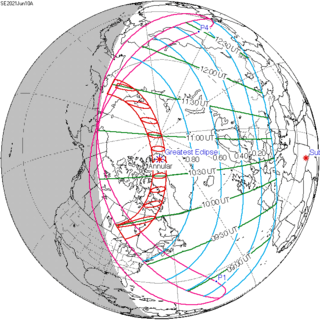 Annular |
152 | December 4, 2021 Total | ||
Saros 127
It is a part of Saros cycle 127, repeating every 18 years, 11 days, containing 82 events. The series started with partial solar eclipse on October 10, 991 AD. It contains total eclipses from May 14, 1352 through August 15, 2091. The series ends at member 82 as a partial eclipse on March 21, 2452. The longest duration of totality was 5 minutes, 40 seconds on August 30, 1532.[1]
| Series members 52–62 occur between 1901 and 2100 | ||
|---|---|---|
| 52 | 53 | 54 |
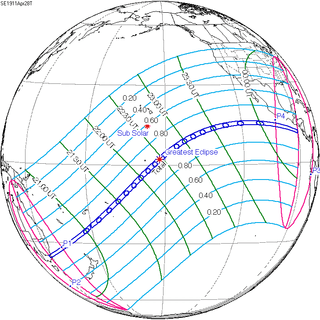 April 28, 1911 |
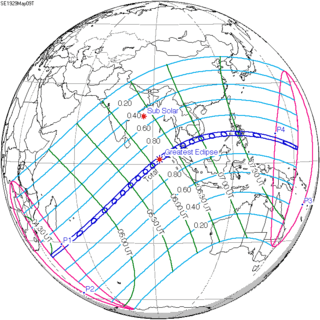 May 9, 1929 |
 May 20, 1947 |
| 55 | 56 | 57 |
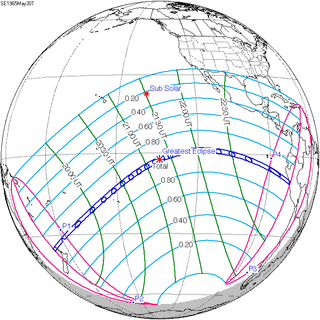 May 30, 1965 |
 June 11, 1983 |
 June 21, 2001 |
| 58 | 59 | 60 |
 July 2, 2019 |
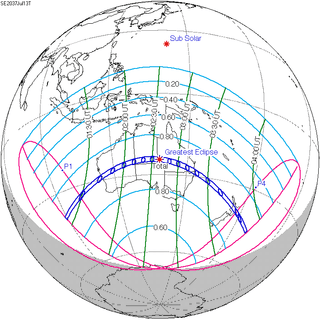 July 13, 2037 |
 July 24, 2055 |
| 61 | 62 | |
 August 3, 2073 |
 August 15, 2091 | |
Metonic series
The metonic series repeats eclipses every 19 years (6939.69 days), lasting about 5 cycles. Eclipses occur in nearly the same calendar date. In addition the octon subseries repeats 1/5 of that or every 3.8 years (1387.94 days).
| 21 eclipse events, progressing from north to south between July 1, 2000 and July 1, 2076 | ||||
|---|---|---|---|---|
| July 1-2 | April 19-20 | February 5-7 | November 24-25 | September 12-13 |
| 117 | 119 | 121 | 123 | 125 |
 July 1, 2000 |
 April 19, 2004 |
 February 7, 2008 |
 November 25, 2011 |
 September 13, 2015 |
| 127 | 129 | 131 | 133 | 135 |
 July 2, 2019 |
 April 20, 2023 |
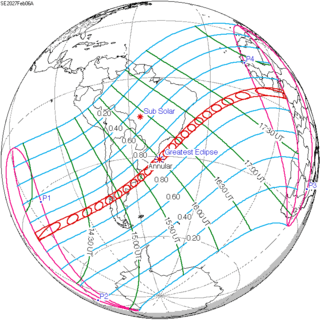 February 6, 2027 |
 November 25, 2030 |
 September 12, 2034 |
| 137 | 139 | 141 | 143 | 145 |
 July 2, 2038 |
 April 20, 2042 |
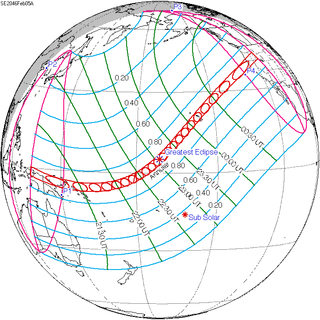 February 5, 2046 |
 November 25, 2049 |
 September 12, 2053 |
| 147 | 149 | 151 | 153 | 155 |
 July 1, 2057 |
 April 20, 2061 |
 February 5, 2065 |
 November 24, 2068 |
 September 12, 2072 |
| 157 | ||||
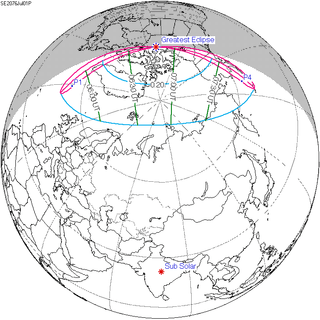 July 1, 2076 | ||||
Notes
References
- Earth visibility chart and eclipse statistics Eclipse Predictions by Fred Espenak, NASA/GSFC
| Wikimedia Commons has media related to Solar eclipse of 2019 July 2. |
